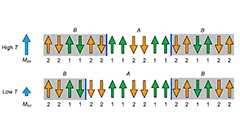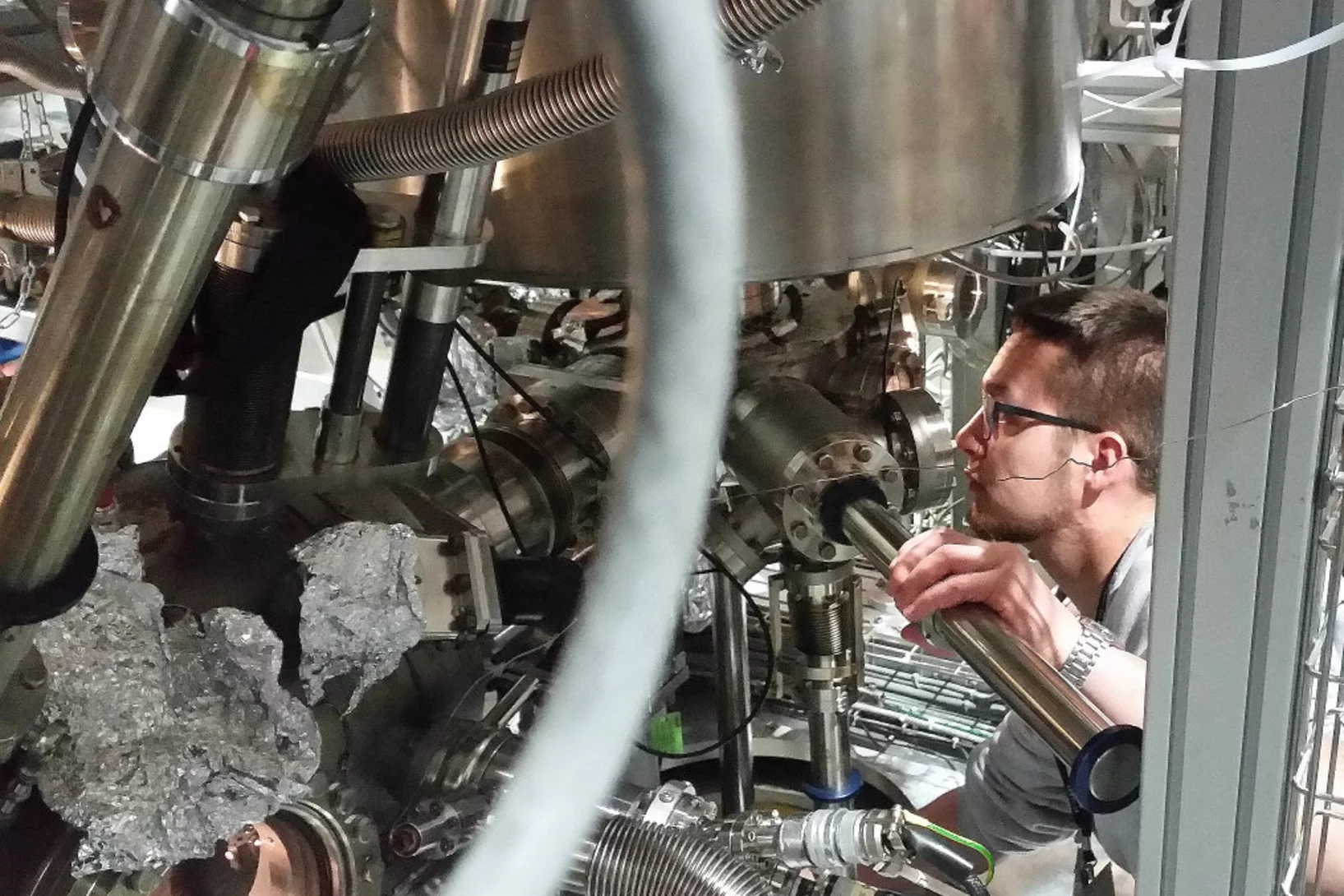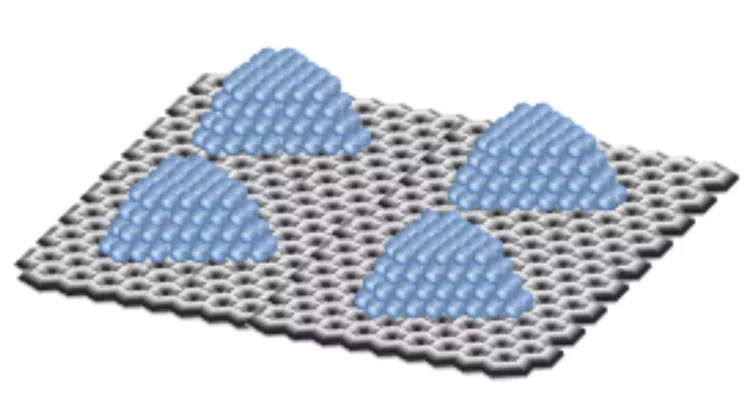Elusive multiferroicity in RNiO3 perovskites
In our recent paper we examined YNiO3 and proved that the RNiO3 type material known for its metal-insulator transition is in fact a type II multiferroic. We provide direct evidence of an electric-field-driven switch of the noncolliear magnetic state finally confirming the proposed type II multiferroic nature of YNiO3.
Mechanism For All-Optical Magnetization Switching
X-rays reveal a non-collinear magnetic state as the base for all-optical magnetization switching.
Unusual ferrimagnetism in CaFe2O4
Rare ferrimagnet states in a phase competing antiferromagnet.
Aperçu de l’avenir magnétique
Des chercheurs du PSI observent pour la première fois un comportement spécifique de la glace magnétique.
Exchange scaling of ultrafast angular momentum transfer in 4f antiferromagnets
A novel approach to controlling the speed of magnetic processes has been found through resonant magnetic scattering in an antiferromagnetic Lanthanide intermetallics.
Single femtosecond laser pulse excitation of individual cobalt nanoparticles
The interaction of light and magnetism at the nanoscale is a topic of fundamental interest and with potential impact to future spintronics applications. in this work we address theoretically and experimentally the effect of femtosecond laser pulse excitation on the magnetic, structural, and chemical stability of individual magnetic cobalt nanoparticles including the role of the substrate or matrix. Eventually, we discuss possible pathways to achieve laser-induced magnetic switching in individual nanostructures.
This work has been highlighted as "Editors' Suggestion" in Physical Review B.
Remote Operation of the PEEM Endstation
We have recently upgraded the PEEM endstation at the SIM beamline to enable remotely controlled experiments via internet and mailed-in samples. Sample positioning and tilt control is now possible by means of a motorized sample stage. A newly developed computer controlled switchbox is available for remote temperature control and in situ application of electric or magnetic fields to the sample.
Novel optics enable better X-ray Free Electron Laser experiments
Our research on multifocus off-axis zone plates was accepted in “Optica”, the highest impact journal of the Optical Society of America. In the paper we report on different ways to combine focusing and beam-splitting functionalities in one single optical element.
Magnon Modes of Microstates and Microwave-Induced Avalanche in Kagome Artificial Spin Ice with Topological Defects
In this work the spin dynamics of microstates in artificial spin ice (ASI) in Ni81Fe19 nanomagnets arranged in an interconnected kagome lattice has been investigated using microfocus Brillouin light scattering, broadband ferromagnetic resonance, magnetic force microscopy, x-ray photoemission electron microscopy, and micromagnetic simulations. The findings are key for the creation of avalanches inside the kagome ASI and reprogrammable magnonics based on ASIs.
Carlos Vaz Selected by the Journal of Materials Chemistry C as Outstanding Reviewer in 2018
SIM beamline scientist Carlos Vaz was recognized as outstanding referee for providing high quality peer review for the Journal of Materials Chemistry C (Royal Society of Chemistry).
HERCULES school 2019 at SLS
In the week of April 1-5 PSI welcomes 20 PhD students and postdocs taking part in the European HERCULES 2019 school on Neutron and Synchrotron Radiation. They will attend lectures and perform two days of practical courses at several beam lines of the Swiss Light Source.
Supramolecular architectures of molecularly thin yet robust free-standing layers
In a collaboration within the network of the Swiss Nanoscience Institute, the formation of free-standing molecular monolayers using self-assembly processes has been demonstrated. The results of the study have been published in the February 2019 issue of Science Advances.
Discrete Hall contribution of magnetic skyrmions
The reliable electrical detection of magnetic skyrmions is of fundamental importance for the application of such topological magnetic quasi-particles for data storage devices. Researchers in a joint collaboration between the University of Leeds and the PolLux endstation have investigated the electrical detection of isolated magnetic skyrmions in applications-relevant nanostructured devices, observing the presence of a strong skyrmion-dependent contribution to the Hall resistivity.
HERCULES at the Swiss Light Source
In the week of March 18-23 PSI welcomes 20 PhD students and postdocs taking part in the HERCULES 2018 school on Neutron and Synchrotron Radiation. They will attend lectures and perform two days of practical courses at several beam lines of the Swiss Light Source.
L'atmosphère à la lumière des rayons X
Des chercheurs du PSI ont développé une chambre d’expérience où ils reconstituent certains processus qui se jouent dans l’atmosphère et peuvent étudier ces derniers avec une précision inégalée grâce à de la lumière de type rayons X issue de la SLS. Lors de leurs premières expériences, ils ont étudié la formation du brome, qui joue un rôle essentiel dans la dégradation de l’ozone dans les couches inférieures de l’atmosphère. A l’avenir, cette nouvelle chambre d’expérience sera également mise à disposition de chercheurs d’autres disciplines scientifiques.
Carlos Vaz Honored by the American Physical Society as Outstanding Referee 2017
SIM beamline scientist Carlos Vaz was recognized as outstanding referee for providing high quality peer review for the journals of the American Physical Society (APS).
In-situ Studies of the Reactivity of Model Catalysts: Surface Chemistry from flat surfaces to nanoparticles
On 7th February Dr. Christian Papp from University Erlangen (Germany) is visiting the SIM beamline and will give a Photon Science Seminar talk with the title: "In-situ Studies of the Reactivity of Model Catalysts: Surface Chemistry from flat surfaces to nanoparticles"
Annual Retreat of the Microscopy & Magnetism Group
The Magnetism and Microscopy group has met for its annual retreat meeting in Lungern 11- 15.1.2017 (in the central mountain region of Switzerland) for extensive discussions on its science program. As for other years, after some general introductory lecture into the techniques used, current and future projects have been presented by the PhD students, postdocs, and scientists as well as from guests who collaborate with the group. Discussion went into the time where dinner has been prepared together, followed by some leisure activities on Saturday.
De nouvelles approches des réactions chimiques grâce aux nanotechnologies
80 % des produits de l’industrie chimique sont fabriqués par recours à la catalyse. Ce procédé est également indispensable dans la conversion énergétique et l’épuration des gaz d’échappement. L’industrie teste donc continuellement de nouvelles substances et de nouvelles configurations susceptibles de déboucher sur de nouveaux procédés catalytiques plus performants. Des chercheurs de l’Institut Paul Scherrer PSI à Villigen et de l’ETH Zurich ont à présent développé une méthode qui permet d’améliorer nettement la précision de tels essais, ce qui devrait accélérer la recherche de solutions optimales.
A la recherche du plus petit bit
Si l’on veut produire à l’avenir des supports de stockage pour média toujours plus compacts, il faut que les domaines magnétiques à les bits de stockage à soient de plus en plus petits. Mais quelle est la taille minimale d’un tel aimant ? Des chercheurs de l’Institut Paul Scherrer PSI étudient les phénomènes surprenants du nanomagnétisme.
Ultrafast structural dynamics of the Fe-pnictide parent compound BaFe2As2
Understanding the interplay of the various degrees of freedom such as the electrons, spins and lattice is essential for many complex materials, including the high-temperature superconductors.
Batman montre la voie vers un stockage de données plus compact
Des chercheurs de l'Institut Paul Scherrer (PSI) ont réussi à renverser l'aimantation de minuscules structures magnétiques grâce à la lumière d'un laser, et à suivre le déroulement de ce retournement au cours du temps. Une zone de quelques nanomètres a alors brièvement clignoté. Fait insolite : sa forme rappelait le logo en forme de chauve-souris de Batman. Les résultats de cette recherche pourraient rendre le stockage de données sur les disques durs plus compact, plus rapide et plus économique.
Nanoscale sub-100 picosecond all-optical magnetization switching in GdFeCo microstructure
Ultrafast magnetization reversal driven by femtosecond laser pulses has been shown to be a promising way to write information. Seeking to improve the recording density has raised intriguing fundamental questions about the feasibility of combining ultrafast temporal resolution with sub-wavelength spatial resolution for magnetic recording. Here we report on the experimental demonstration of nanoscale sub-100 ps all-optical magnetization switching, providing a path to sub-wavelength magnetic recording.





















